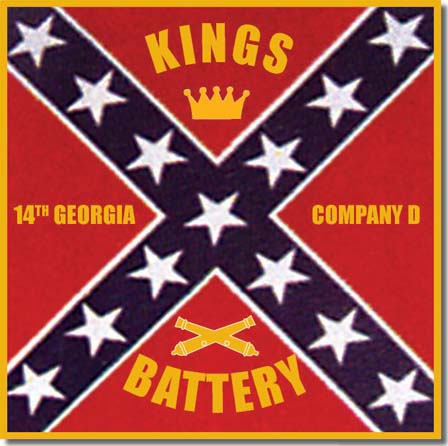History of the original King’s Battery
This company organized as Co. “D”, 14th Georgia Artillery Battalion, Captain Elzaphon R. King, April 21, 1862. Officers and men came from Cedartown, Van Wert and other parts of Polk County GA. The first company roll is dated Camp Golgotha near Griffin GA, May 31, 1862. The company was still there on July 1, 1862. The station changed to Camp Randolph near Calhoun GA by the end of August 1862, where King's Battery remained as late as October 6th. While at Camp Randolph, Capt. King drew rations for 54 horses, enough for nine six-horse teams. That suggests that his company was equipped with four guns, four caissons and a battery wagon.
Shortly after the army returned from Kentucky, the battalion reported to camp at Murfreesboro TN. It was included with the army’s reserve artillery on November 27, 1862. About the same time officers and men of Company ”F”, 14th Georgia Artillery Battalion, Capt. James G. Gibson, were reassigned to King’s Company “D”. Capt. Gibson resigned his commission on Dec. 5, 1862, followed a matter of days later by Lieuts. W. R. Beck and W. B. S. Davis. Apparently Lieut. Micajah W. Thweatt also resigned and left the battery. He later reappears as a private of Co. “G”, 28th Georgia Artillery Battalion. King’s Battery isn’t on an order of battle for the Battle of Murfreesboro TN. All references to the 14th Georgia Artillery Battalion vanish about this time.
By virtue of S.O. 105, Army of Tennessee, May 8, 1863, General Braxton Bragg reassigned virtually all King's officers and men to Lumsden’s Alabama Battery, Anderson's Georgia Battery and Massenburg’s Georgia Battery. For whatever reason, battery members were not given actual transfers but simply reassigned. Transfers to other batteries took place in December of 1863. Saying that King’s Battery had been broken up and he was a super-numerary officer assigned to Barret's Missouri Battery, Lieut. J. F. Brice resigned his commission in March 1864.
It does not appear that King’s Georgia Battery was ever involved in any action, although battery members evidently served with other fighting commands. For instance, E. R. King ended the war as a private serving with Van den Corput’s Georgia Battery.


